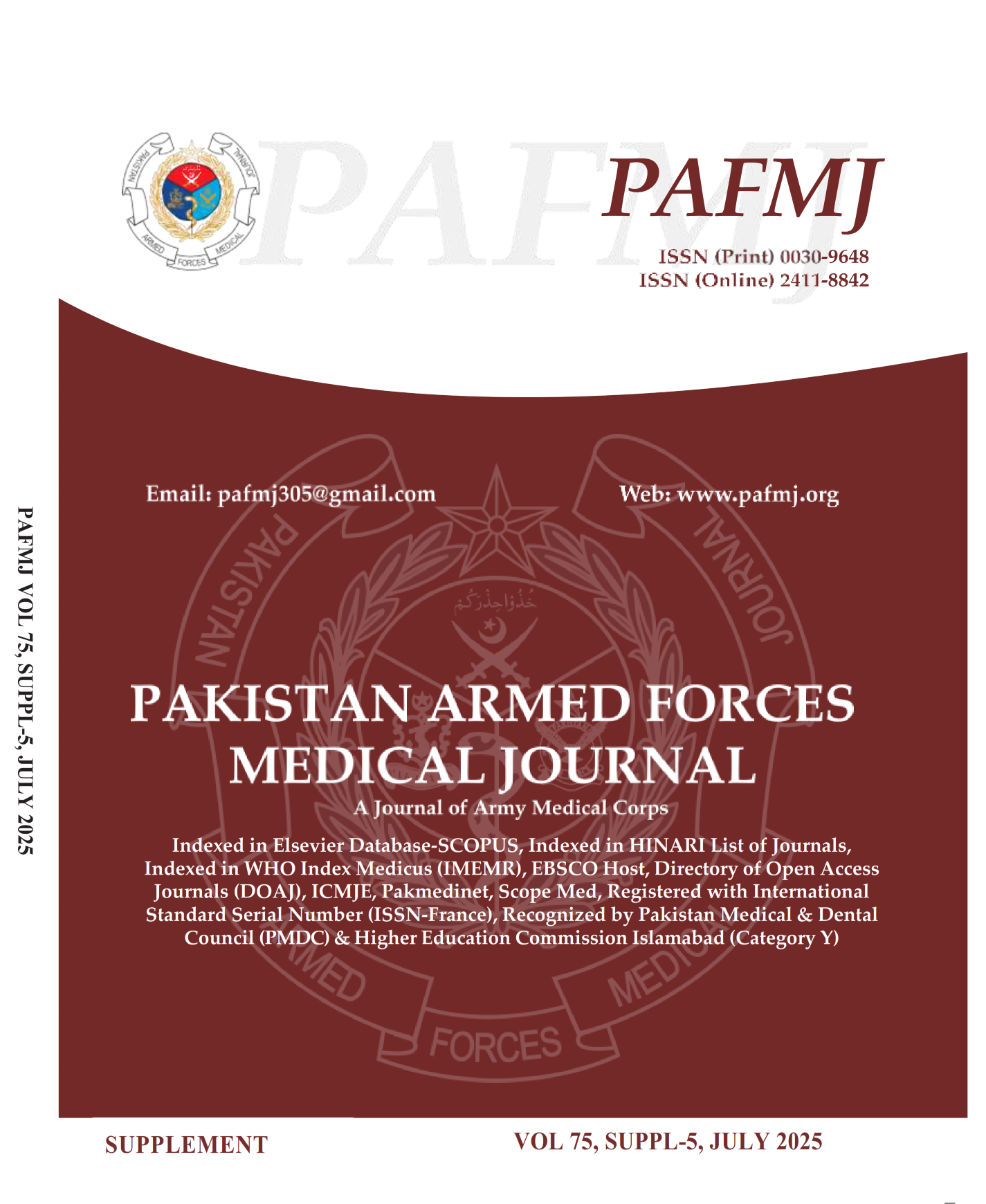Comparison of Polypropylene (Prolene) Versus Polydioxanone(Pds) In Abdominal Wall Closure After Laparotomy
DOI:
https://doi.org/10.51253/pafmj.v75iSUPPL-5.7899Keywords:
mass closure abdomen, polypropylene, polydioxanoneAbstract
Objective: To compare polypropylene (non-absorbable) versus polydioxanone (delayed absorbable) suture for abdominal wound closure after laparotomy
Study Design: Quasi-experimental study
Place and Duration of Study: Department of General Surgery Combined Military Hospital Quetta, Pakistan from May 2020 to June 2021.
Methodology: Total 140 patients (70 each Group) of elective laparotomy who met the inclusion criteria were included. Patients with complications, previous surgery or emergency surgery were excluded. In Group A mass closure of anterior abdominal wall was done with polypropylene while in Group B mass closure was done with polydioxanone. All patients were followed for six months post operatively for complications.
Results: Total 140 patients were included in the study. The mean age in Group A was 44.57±12.87 years and in Group B it was 48.47±11.45 years. There were 75(53.5%) males and 65(46.5%) females. Post operatively 29 patients (41.4%) in Group A and 20 patients (28.5%) in Group B developed surgical site infection. 10 patients (14.2%) of Group A and 8 patients (11.4%) of Group B developed incisional hernia. In Group A 5 patients (7.14%) had burst abdomen postoperatively while in Group B, 4 patients (5.71%) had burst abdomen.
Conclusion: We conclude that PDS (with antibacterial coating) has reduced inflammatory reaction and has better tissue regeneration. PDS is better as it has low surgical site infection, low wound dehiscence and incisional hernia formation when compared with prolene.
Downloads
References
1. Choi HB, Chung D, Kim JS, Lee TH, Baek SJ, Kwak JM, Kim J, Kim SH. Midline incision vs. transverse incision for specimen extraction is not a significant risk factor for developing incisional hernia after minimally invasive colorectal surgery: multivariable analysis of a large cohort from a single tertiary center in Korea. Surg.Endosc. 2022 ; 36(2): 1199-205.
2. Pai D, Shenoy R, Chethan K. Comparison of non-absorbable (polypropylene) versus delayed absorbable (polydioxanone) suture material for abdominal wound closure after laparotomy. Int Surg J 2018; 5: 1690-6.
3. Cherla DV, Poulose B, Prabhu AS. Epidemiology and Disparities in Care: The Impact of Socioeconomic Status, Gender, and Race on the Presentation, Management, and Outcomes of Patients Undergoing Ventral Hernia Repair. Surg Clin North Am 2018 Jun; 98(3): 431-40.
4. Lai LW, Roslani AC, Yan YW, Bhojwani KM, Jamaluddin MF. Comparison of post‐operative pain in short versus long stitch technique for abdominal wall closure after elective laparotomy: a double‐blind randomized controlled trial. ANZ J. Surg. 2021 May; 91(5): 896-901.
5. Burute SB, Karan A, Puri M, Sansare S. Efficacy of different types of sutures materials used in the wound closure of pfannenstiel skin incision by subcuticular technique in cesarean section. Int J Clin Obstetr Gynaecol. 2019; 3(1): 150-3.
6. Devick IF, Hendrickson DA. Complications Associated with Sutures. Complications in Equine Surgery. 2021 Apr 23: 70-8.
7. Jose Ignacio Ortiz de Elguea-Lizarraga et al Biomechanical evaluation of suture materials used for abdominal fascial closure.Mater.Res. Express.2021; 8.115
8. Henriksen, N. A.; Deerenberg, E. B.; Venclauskas, L.; Fortelny, R. H.; Miserez, M.; Muysoms, F. E. Meta-analysis on Materials and Techniques for Laparotomy Closure: The MATCH Review. World J. Surg.2018; 42(6): 1666-1678.
9. Patel SV, Paskar DD, Nelson RL, Vedula SS, Steele SR. Closure methods for laparotomy incisions for preventing incisional hernias and other wound complications. Cochrane Database Syst.Rev. 2017; 11.
10. Gorad K, Rahate V, Shinde G, Taralekar G, Prabhu V, Singh L. Use of Southampton Scoring for Wound Healing in Post-surgical Patients: Our Experience in Semi-urban Setup. Arch.clin.biomed.res. 2021; 5(1): 36-41.
11. A Bloemen, P van Dooren, B F Huizinga, A G M Hoofwijk, Randomized clinical trial comparing polypropylene or polydioxanone for midline abdominal wall closure, Br J Sur. 2011; 98(5): 633–639
12. Samartsev, Vladimir, Kuchumov, Alex and Gavrilov, Vasiliy. "Sutures in abdominal surgery: biomechanical study and clinical application. Open Med.J.2014; 9(6): 849-859.
13. Khan N, Almas D, Shehzad K, Chaudhry A, MIAN M. COMPARISON BETWEEN DELAYED–ABSORBABLE POLYDIOXANONE AND NON-ABSORBABLE (PROLENE) SUTURE MATERIAL IN ABDOMINAL WOUND CLOSURE. PAFMJ.2009; 59(1): 64-9.
14. Weiland D, Bay R, Del Sordi S. Choosing the best abdominal closure by meta-analysis. Am J Surg. 1998; 176(6): 666-70
15. Sajid M, Parampalli U, Baig M, McFall M. A systematic review on the effectiveness of slowlyabsorbable versus non-absorbable sutures for abdominal fascial closure following laparotomy. Int J Surg. 2011; 9(8): 615-25.
16. Kushner BS, Arefanian S, McAllister J, Tan WH, Grant M, MacGregor R, Majumder A, Blatnik JA. Examination of abdominal wall perfusion using varying suture techniques for midline abdominal laparotomy closure. Surg. Endosc. 2021; 27: 1-9.
17. Van ‘t Riet M, Steyerberg EW, Nellensteyn J, Bonjer HJ, Jeekel J.Meta-analysis of techniques for closure of midline abdominal incisions.Br J Surg.2002; 89: 1350–1356
18. Chalya P, Massinde A, Kihunrwa A, Mabula J. Abdominal fascia closure following elective midline laparotomy: a surgical experience at a tertiary care hospital in Tanzania. BMC Res.Notes. 2015; 8(1).
19. Agrawal V, Sharma N, Joshi M, Minocha V. Role of suture material and technique of closure in wound outcome following laparotomy for peritonitis. Tropical Gastroenterol. 2009; 30(4): 237-40.
Downloads
Published
Issue
Section
License
Copyright (c) 2025 Lajpat Rai, Umair Masood, Ali Naqi, Rutaba Alam, Attaullah ., Fahim Liaqat

This work is licensed under a Creative Commons Attribution-NonCommercial 4.0 International License.















